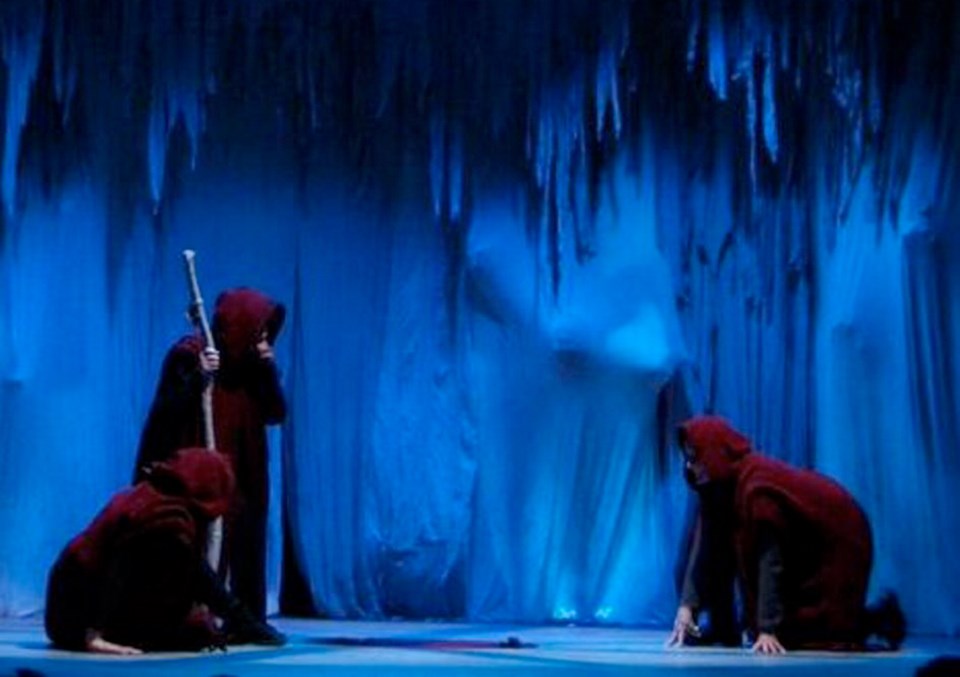REVIEW
MacbethWhere: Blue Bridge at the Roxy, 2657 Quadra St.
When: Until May 17
Tickets: $24.50-$42
Reservations: ticketrocket.org, 250-590-6291
Rating: Four stars out of five
Something wickedly entertaining this way comes in Blue Bridge Repertory Theatre’s Macbeth, a cleverly crafted production that makes up in stylized drama and stagecraft what it lacks in magnitude.
The Bard is alive and magic is afoot in director Brian Richmond’s scaled-down version of the tragedy set in medieval Scotland where the Weird Sisters, the three witches, deliver three prophecies.
While they predict Macbeth will eventually become King of Scotland, he’ll first be titled Thane of Cawdor and future heirs to the throne will descend not from Macbeth but comrade-in-arms Banquo.
As this brooding tale of treachery, witchcraft and murder unfolds — think old-school Game of Thrones, kids — having a passing familiarity with the material is beneficial.
Essential plot points include “the deed” Macbeth must carry out with unrelenting pressure from Lady Macbeth — murdering King Duncan so he can seize the crown; the kingdom’s lords’ vow to avenge the mysterious murder; King Duncan’s son Malcolm’s flight to England; Macbeth’s plot to kill Banquo and surviving son Fleance, and then nobleman-turned-nemesis Macduff.
With a multitude of characters portrayed by its main six-person cast, following the action could prove challenging for some. On opening night, one theatregoer was overheard saying “I thought he was dead” when Chris Mackie, who plays ill-fated Banquo, resurfaced later as Macduff.
Despite the creative liberties, however, Richmond’s daring condensed production — highlighted by a goateed Jacob Richmond’s commanding performance as the warrior king — proved as accessible as it was visually striking.
Even Celine Stubel, who plays Lady Macbeth, effectively assumes additional roles — as Hecate and the third murderer. It’s Iris MacGregor-Bannerman, Shauna Baird and Grace Vukovic, as the Weird Sisters, who assume the most, however, collectively portraying two dozen other integral characters.
It’s apparent we’re in for a boldly reimagined take from the start, as the witches appear in hooded crimson cloaks, concocting a creation on a circular grey stage crowned with what ironically resembles a huge halo. A layered semi-circle curtain of tattered light grey fabrics hangs from it, framing the action below.
With considerable success, Richmond creatively exploits this simple, yet functional, set designed by Laurin Kelsey and Tamara Marie Kucheran. It heightens the material’s timelessness and provides an effective backdrop to emphasize mythological and allegorical aspects.
Even when he stumbled over a line or two during his classic soliloquies on opening night, Jacob Richmond conveyed confidence unflinchingly as Macbeth, turning in a beautifully modulated performance, mercifully free of dramatic overkill. With effective understatement, he captures the increasingly haunted Macbeth’s alternating fury, fear and paranoia.
Despite Stubel’s obvious acting talents seen in Who’s Afraid of Virginia Woolf and Venus in Fur, Lady Macbeth doesn’t seem as suitable a fit. She delivers a solid enough performance and some powerful soliloquies — notably her “unsex me” plea — but she didn’t capture this ruthlessly manipulative villain’s derangement and ferocity as convincingly as we had hoped.
Capitalizing on his brawny physique, Mackie impressively differentiates the dual roles of Banquo and Macduff.
Impressive indeed are the eclectic contributions of the Weird Sisters portrayed by MacGregor-Bannerman, whose secondary characters include Duncan, first murderer and messenger; Baird, whose other roles include the captain who first recounts the battle, the porter and Lady Macduff; and Vukovic, a bright young talent who also plays Malcolm and the sons of Banquo and Macduff, among others.
(Sporting a thick Scottish accent, Baird is particularly amusing as the hunched porter delivering the “Knock, knock! Who’s there in the name of Beelzebub?” line.)
Part of the fun of watching Macbeth is identifying the origins of common sayings, as when the porter observes drink “provokes the desire but it takes away the performance.”
It also reminds you how Shakespeare’s original power couple inspired modern variations such as Frank and Claire Underwood in House of Cards.
The consistently dark and menacing tone Brian Richmond conjures in tandem with his first-rate creative collaborators is a big plus. His use of a blood-red fabric, centrepiece of the striking grey-and-red colour scheme, is particularly good. Highlights include the dramatic effect it achieves during Macbeth’s initial ascension, how it billows so evocatively as the bubbling cauldron and its transformation into the round table during the royal banquet.
The clever stagecraft even takes on a horror-movie feel as bodies push against fabric screens from behind, where silhouettes of dagger-wielding and goblet-clutching characters also heighten the drama.
The metaphysical mayhem is greatly enhanced by John Mills-Cockell’s ominous electronic score and sound design that replicates the sounds of ravens, thunder, bells and more, and by the comings-and-goings of apparitions embodied by Chloe Dufort, Jensen Kerr, Levi Schneider and Nicola Whitney-Griffiths.
Integral to the dramatic impact are Kucheran’s stunning blend of contemporary and medieval costumes, Treena Stubel’s choreography and Rebekah Johnson’s moody lighting design.
